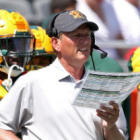The MVP of the Alliance of American Football's Week 1 wasn't a player at all. It was a game feature -- mic'd up instant replay -- and its subject was the first touchdown in the history of the Alliance.
During the second quarter of the Orlando Apollos game against the Atlanta Legends, Apollos wide receiver Jalin Marshall brought in a tough catch over the middle of the field, while double-covered, and landed in the end zone. Even though it was a tremendous effort on Marshall's end, the play was ruled an incomplete pass. However, Apollos coach Steve Spurrier challenged the call and it went upstairs, where replay official Terri Valenti took a more detailed look at the different camera angles. She talked through what she was seeing, as she normally would, except this time microphones were on to catch the whole thing. Valenti said the call was likely to stand due to lack of indisputable evidence, but then she halted as another angle came on the screen.
"Wait a minute, one second," said Valenti. "We've got an elbow down ... he's got it. Nope, we're going to overturn this and reverse this to a catch in the end zone for a score by Orlando. He's got possession, he tucks it in. His elbow hits. The ball was in control in his arms. We've got a score."
"We've got a score."
— CBS Sports (@CBSSports) February 10, 2019
After some careful consideration, @aafAPOLLOS get the first touchdown in the history of @TheAAF. pic.twitter.com/dCTBYvCEMF
Overturning a call wasn't some novel feature by itself, but getting an inside peek into the decision-making process as it unfolded in real time was. The mic'd up replays were the hit of opening night across social media, and while mediums like Twitter can be a fish bowl with reactions, it did serve as a reminder that football fans crave transparency.
"We want to let people see what goes on behind the scenes, and there's always been kind of a shroud of secrecy when it comes to replay," said Mike Pereira, officiating consultant to the AAF. "What are you showing? What angles are you seeing? Are you seeing different angles than the person that's on the scene? We always said -- which was the truth -- the only thing the replay uses is what TV shows. But it's always been a bit of a mystery, and that includes the conversation as to what is said, and even sometimes what is looked at."
The genesis for the mic'd up replay official came from AAF CEO Charlie Ebersol, who worked with CBS to peel back the curtain on one of football's biggest mysteries. Ebersol positioned his league to be about entertainment and instant replay would not stray from that purpose. At the end of the day, everything the AAF does in two-and-a-half hours is about trying to keep the audience engaged from start to finish -- even during the down times.
"Look, we're out to show a different product. We're out to show something that uses technology more and to make it more fun to watch," Periera said. "One of the most boring things of a replay stop is when you have a three-minute stop, and you don't have a commercial break, and then you're sitting there, and sitting there, and sitting there, and waiting, and waiting, and all you're doing is maybe showing more replays."
Will Brinson and Sean Wagner-McGough pick the Week 2 AAF games on the Pick Six Podcast, check it out here:
There are countless instances in the past, at every level of football in which there is instant replay, when an official goes to the replay booth only to return eons later with a the final word. In the meantime, fans are left wondering what is happening in the booth. Bill Polian, the AAF's co-founder and head of football, understood this. In addition to putting a mic on the replay official, limiting the replays to two challenges per coach -- a closer representation of the process when it was introduced in the NFL in 1999 -- was paramount for the flow of the game.
"As a longtime opponent of the intrusiveness and the length of replay into the game, we wanted to design our system so that it's as fast as it possibly can be, and the least intrusive that it can be," he said. "There's nothing worse than sitting there and watching someone watch a screen ... It's dead time, and it's dead time with no real conclusion a lot of the times, or the wrong conclusion a lot of times.
"So we designed our game with only four replays. We're not replaying anything that isn't challenged. So we want a fast moving game, we don't want those intrusions," Polian continued. "That said, if you're eavesdropping so to speak on an ongoing process, that's a bit different than the kind of elongated process we have in the NFL, and frankly in other sports as well."
That doesn't ensure fans will always agree with the conclusion of the replay -- in fact, here's betting that will rarely be the case -- but at least they know the process. And, to be sure, the AAF's replay officials aren't perfect. In the Week 1 game between the Birmingham Iron and Memphis Express, an incomplete pass from quarterback Luis Perez was incorrectly changed to a completion.
and what a beauty it was 👊 #MEMvsBHM #ForgeOn⚒️🔥 pic.twitter.com/LLovUTvBVM
— Birmingham Iron (@aafiron) February 10, 2019
Mistakes happen. It's part of the human element of the game. And as Pereira pointed out, the AAF isn't just a development league for players, it's a development league for officials as well. Still, it's the type of idea that makes you wonder why it wasn't done sooner -- namely in the NFL, which has taken plenty of flak for how it conducts itself both with officiating and instant replay. But there are stark logistical contrasts between the eight-team AAF, which will broadcast one game at a time starting in Week 2, and the 32-team NFL, which routinely plays all but two of its games on Sunday. The AAF can afford to have a replay official on-site going over one challenge at a time. The NFL puts its instant replay crew in New York in the Art McNulty GameDay Center.
In short, don't expect the NFL to adopt what viewer's saw in the AAF in Week 1, at least not in its entirety. Polian noted that the NFL will always look at different concepts to incorporate into its business; there would be no SkyCam, for example, without the XFL. But for as buttoned-up as the league can be about things, and officiating certainly falls within that description, putting a camera and microphone into the replay center might be a bit of a stretch.
"That becomes a little bit more difficult because you have multiple games going on at the same time, so if you have two replays going on at the same time and you're bouncing around, I'm not sure," Pereira said. "My overall inclination would be that they would probably not do this, just because it's not a decision that's made at the stadium like it is in the Alliance. It's a decision that's made in New York and would be a little bit prohibitive from having television cameras inside their command center, period."
Then again, the AAF is not an idea farm for the NFL. Even though it's no secret the two are conjoined in developing not just players, but coaches, staff members, and yes, even officials, the AAF doesn't present its product as some updated version of professional football for the NFL to adopt. The NFL can take as long as it wants and be as ambiguous as it wants in officiating because it knows people will continue to watch. The AAF does not have that luxury.
But it has used its novelty and size to try out different ideas. In addition to the mic'd up replay booth, the AAF has a SkyJudge that serves as the ninth member of the officiating crew. High above the field, the SkyJudge, the brainchild of Pereira and Polian, is perched in a way that gives them a 360-degree view of the field. Their job is in real time, looking for egregious plays that may have been missed that directly affect safety or integrity of the game. It's different from replay, but it serves an equally important purpose in getting calls on the field correct as often as possible.
Obviously, fans who watch the NFL can think of an example of when the SkyJudge would have helped: the blatant missed pass interference call in the NFC Championship Game between the Los Angeles Rams and New Orleans Saints. While that play was not the genesis of the SkyJudge, it is in an instance that would have benefited from it.
That's not to say the NFL needs to adopt the SkyJudge specifically, but again, the mystery behind the call is probably just as frustrating for viewers as the call itself. Be it the SkyJudge or mic'd up replay officials, the AAF has aimed to make sure that cloud of ambiguity is erased.
"I'm all for eliminating mystery, because mystery leads to conspiracy, and conspiracy is one of the things that frustrates people and gets people upset," said Pereira. "So, the more you can be open, and I don't see anything you have to hide. I mean, essentially, what's gained by not showing that? Everything to me is a positive, so you can actually see what's going on, and in some cases kind of feel what's going on."
















